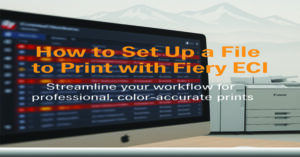How to Set Up a File to Print with Fiery ECI
If you’ve ever needed to print something important—like a full-color marketing brochure, a detailed proposal, or a stack of postcards—and wondered how to make sure it comes out exactly right, then you’re in the right place.
When you’re using a professional digital printer from Canon, Xerox, or Ricoh, and your job depends on precision and color accuracy, Fiery ECI is likely your best friend. But if you’re new to Fiery or just haven’t had time to explore all it can do, this guide will walk you through the process, step by step.
Whether you’re managing print jobs for a busy Denver design firm or running a local real estate office in Colorado Springs, learning how to properly set up a file for Fiery can save you time, money, and a whole lot of frustration.
First Things First: What Is Fiery ECI?
Fiery ECI is a powerful digital front-end (DFE) system made by EFI. It acts like a translator between your computer and your digital printer—turning your file into a flawless print job with accurate colors, layout consistency, and finishing precision.
If your printer uses Fiery, you’ll likely be working with Fiery Command WorkStation, the software interface where you send and manage your print jobs. It gives you total control over how your file prints—from color settings and imposition to duplexing and finishing.
Think of it as your mission control for printing. And once you get the hang of it, you’ll wonder how you ever lived without it.
Step 1: Prep Your File for Success
Before you even open Fiery Command WorkStation, your print job starts with your file. Whether you’re working in Adobe InDesign, Illustrator, Photoshop, or even Microsoft Word, the way you set up your file plays a huge role in how it looks on paper.
Here’s what to keep in mind:
- Always design in CMYK if possible. RGB might look great on screen, but CMYK is the language of print.
- Use high-resolution images—300 dpi is the gold standard.
- Add bleed and crop marks. A standard 1/8″ (0.125″) bleed helps prevent white edges when trimmed.
- Flatten your transparencies if you’re using InDesign or Illustrator.
- Outline your fonts or embed them to prevent shifting or errors.
Once everything looks just right, it’s time to export your file to a print-ready PDF.
Step 2: Export Your File as a PDF/X
Fiery works best with PDF/X formats, which are designed specifically for printing.
If you’re using Adobe software:
- Go to File > Export (InDesign) or File > Save As > Adobe PDF (Illustrator/Photoshop).
- Choose PDF/X-1a or PDF/X-4.
- Under Marks and Bleeds, enable Crop Marks and check “Use Document Bleed Settings.”
- In the Output tab, either leave color conversion off or convert to your press’s ICC profile.
Now you’ve got a print-ready file Fiery can work with beautifully.
Step 3: Launch Fiery Command WorkStation
Now comes the fun part—setting up your job in Fiery Command WorkStation, or CWS for short.
Once you launch the software and connect to your Fiery server, you’ll see queues like Held, Printed, and Archived. This is where you manage jobs with full visibility.
Don’t worry—it might look complex at first, but it’s user-friendly once you dive in.
Step 4: Import Your File into Fiery
There are two easy ways to bring your file into Command WorkStation:
Option A: Drag and Drop
Drag your PDF from your desktop into the Held queue in Fiery to preview and adjust settings before printing.
Option B: Use the Import Feature
Click the Import Job button or go to File > Import Job and select your PDF. Choose “Hold,” “Print Now,” or “Print and Hold.”
Pro Tip: Holding your job first lets you double-check settings—ideal for custom media or color-critical work.
Step 5: Adjust Print Settings in Job Properties
Right-click your job and choose Properties to customize print details:
📄 Media Tab
Set paper size, weight, and trays. Ensure custom media (like glossy cover stock) is correctly selected.
🎨 Color Tab
Choose a color profile (GRACoL, SWOP), use Fiery Spot-On to match brand colors, or enable enhancements.
🔄 Layout Tab
Use for imposition settings like business cards (2-up) or booklets.
📑 Finishing Tab
Enable stapling, folding, or punching if your printer supports it.
🔁 Duplexing
Set single- or double-sided output and choose the flip option if needed.
This step is where Fiery’s power shines—letting you fine-tune every detail.
Step 6: Preview Your File with ImageViewer
Use Fiery ImageViewer to soft-proof your print before it hits paper.
Zoom, inspect fonts, verify bleeds, and catch alignment or color issues early.
It’s your safety net for quality control.
Step 7: Hit Print or Send It to the Queue
Click Print or send your file to the Print queue. Fiery will RIP (process) the job and send it to your printer just as configured.
And just like that, you’re producing flawless, professional prints!
Step 8: Save a Preset for Next Time
Printing similar jobs often? Save your setup as a Preset in Fiery Job Properties.
Next time, it’s one click to replicate settings—an efficiency boost your whole team will love.
Quick Troubleshooting Tips
Run into issues? Start here:
- Colors look off? Confirm CMYK and ICC profiles.
- Fonts missing? Embed or outline them.
- Misfeeds? Check media type and trays.
- Not printing? Verify you’re connected to the right Fiery server.
Still stuck? Call your local ABT experts—we’re just around the corner in Colorado.
Why Fiery Printing is a Game-Changer for Colorado Businesses
From Fort Collins print shops to real estate offices in Denver, Fiery ECI helps businesses run smarter.
- Spot-on color accuracy
- Simplified workflows for recurring jobs
- Advanced imposition for complex layouts
- Real-time previews to prevent waste
When you work with ABT, you get top-tier print performance—and a local partner who gets your business.
Final Thoughts
Learning to set up a file with Fiery ECI may feel technical at first—but once you do it a few times, it’s a breeze. And the payoff? Stunning prints, greater control, and zero surprises at the output tray.
At ABT, we help Colorado businesses unlock Fiery’s full potential—from color setup to workflow automation. Let us simplify your print process.
Ready to streamline your print workflow?
📞 Contact ABT today to schedule a Fiery consultation or on-site training.
Let’s make your print jobs faster, sharper, and smarter—together.

